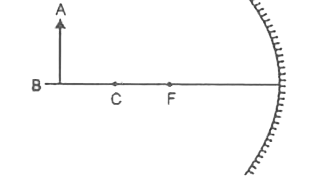Suppose that the lower half of the concave mirror’s reflecting surface in Fig. 9.5 is covered with an opaque (non-reflective) material. What effect will this have on the image of an object placed in front of the mirror?Solution in Gujrati
You may think that the image will now show only half of the object, but taking the laws of reflection to be true for all points of the remaining part of the mirror, the image will be that of the whole object. However, as the area of the reflecting surface has been reduced, the intensity of the image will be low (in this case, half).
Topper's Solved these Questions
- RAY OPTICS AND OPTICAL INSTRUMENTSBOOK - NCERT GUJARATICHAPTER - RAY OPTICS AND OPTICAL INSTRUMENTSEXERCISE - EXERCISES
40 Videos
- NUCLEIBOOK - NCERT GUJARATICHAPTER - NUCLEIEXERCISE - ADDITIONAL EXERCISES
9 Videos
- SEMICONDUCTOR ELECTRONICS: MATERIALS, DEVICES AND SIMPLE CIRCUITSBOOK - NCERT GUJARATICHAPTER - SEMICONDUCTOR ELECTRONICS: MATERIALS, DEVICES AND SIMPLE CIRCUITSEXERCISE - ADDITIONAL EXERCISES
8 Videos
Similar Questions
A small candle, 2.5 cm in size is placed at 27 cm in front of a concave mirror of radius of curvature 36 cm. At what distance from the mirror should a screen be placed in order to obtain a sharp image? Describe the nature and size of the image. If the candle is moved closer to the mirror, how would the screen have to be moved?
View SolutionIn a periodic table the average atomic mass of magnesium is given as 24.312 u. The average value is based on their relative natural abundance on earth. The three isotopes and their masses are 2412Mg(23.98504u),2512Mg(24.98584u)and2612Mg(25.98259u). The natural abundance of 2412Mg is 78.99% by mass. Calculate the abundances of other two isotopes.
View SolutionThe number of silicon atoms per m3 is 5×1028. This is doped simultaneously with 5×1022 atoms per m3 of Arsenic and 5×1020 per m3 atoms of Indium. Calcualte the number of electrons and holes. Given that ni=1.5×1016m−3. Is the material n-type or p-type?
View SolutionSuppose that the lower half of a concave mirror's reflecting surface is covered with an opaque non-reflecting material. What effect will this have on the image of an object placed in front of the mirror ?
View Solutionमान लीजिये चित्र 9 . 5 में दर्शाए अवतल के परावर्तक पृष्ठ के निचे का आधा भाग किसी अपारदर्शी ( अपरावर्ती ) पदार्थ से ढक दिया गया है | दर्पण के सामने किसी बिम्ब के दर्पण द्वारा बने प्रतिबिम्ब पर इसका क्या प्रभाव पड़ेगा ?
View Solutionनिम्न चित्र में प्रदर्शित अवतल दर्पण के परावर्तक पृष्ठ के नीचे का आधा भाग किसी अपारदर्शी पदार्थ से ढक दिया गया है। दर्पण के सामने स्थित किसी प्रतिबिंब के दर्पण द्वारा बने प्रतिबिंब पर इसका क्या प्रभाव पड़ेगा?

View SolutionSuppose that the lower half of the concave mirror's reflecting surface in figure is covered with an opaque (non-reflective) material. What effect will this have on the image of an object placed in front of the mirror ?
View SolutionSuppose that the lower half of a concave mirror's reflecting surface is covered with an opaque non-reflecting material. What effect will this have on the image of an object placed in front of the mirror ?
View SolutionLower half of the concave mirror is painted black. What effect will this have on the image of an object placed in front of the mirror?
View Solutionएक वस्तु AB को चित्र में दिखाए अनुसार , एक अवतल दर्पण के सामने रखा गया है।
(i) वस्तु का प्रतिबिम्ब दर्शाने के लिए किरण आरेख को पूरा कीजिये ।
(ii) यदि दर्पण की परावर्तक सतह के निचले आधे भाग पर काला पेन्ट कर दिया जायें तो प्रतिबिम्ब की स्थिति तथा तीव्रता पर क्या प्रभाव होगा ?

View SolutionSuppose that the lower half of the concave mirror's reflecting surface is covered with an opaque (non-reflective ) material. What effect will the have on the image of an object placed in front of the mirror ?
View SolutionSuppose that the lower half of the concave mirror’s reflecting surface in Fig. 9.5 is covered with an opaque (non-reflective) material. What effect will this have on the image of an object placed in front of the mirror?
View SolutionSuppose that the lower half of the concave mirror’s reflecting surface in Fig. 9.5 is covered with an opaque (non-reflective) material. What effect will this have on the image of an object placed in front of the mirror?
View SolutionSuppose that the lower half of a concave mirror's reflecting surface is covered with an opaque non-reflecting material. What effect will this have on the image of an object placed in front of the mirror ?
View Solution(a) A mobile phone lies along the principal axis of a concave mirror. Show by suitable diagram the formation of its image. Explain, why the magnification is not uniform.
(b) Suppose the lower half of the concave mirror's reflecting surface is covered with an opaque material, what effect this will have on the image of the object ? Explain.
View Solution
